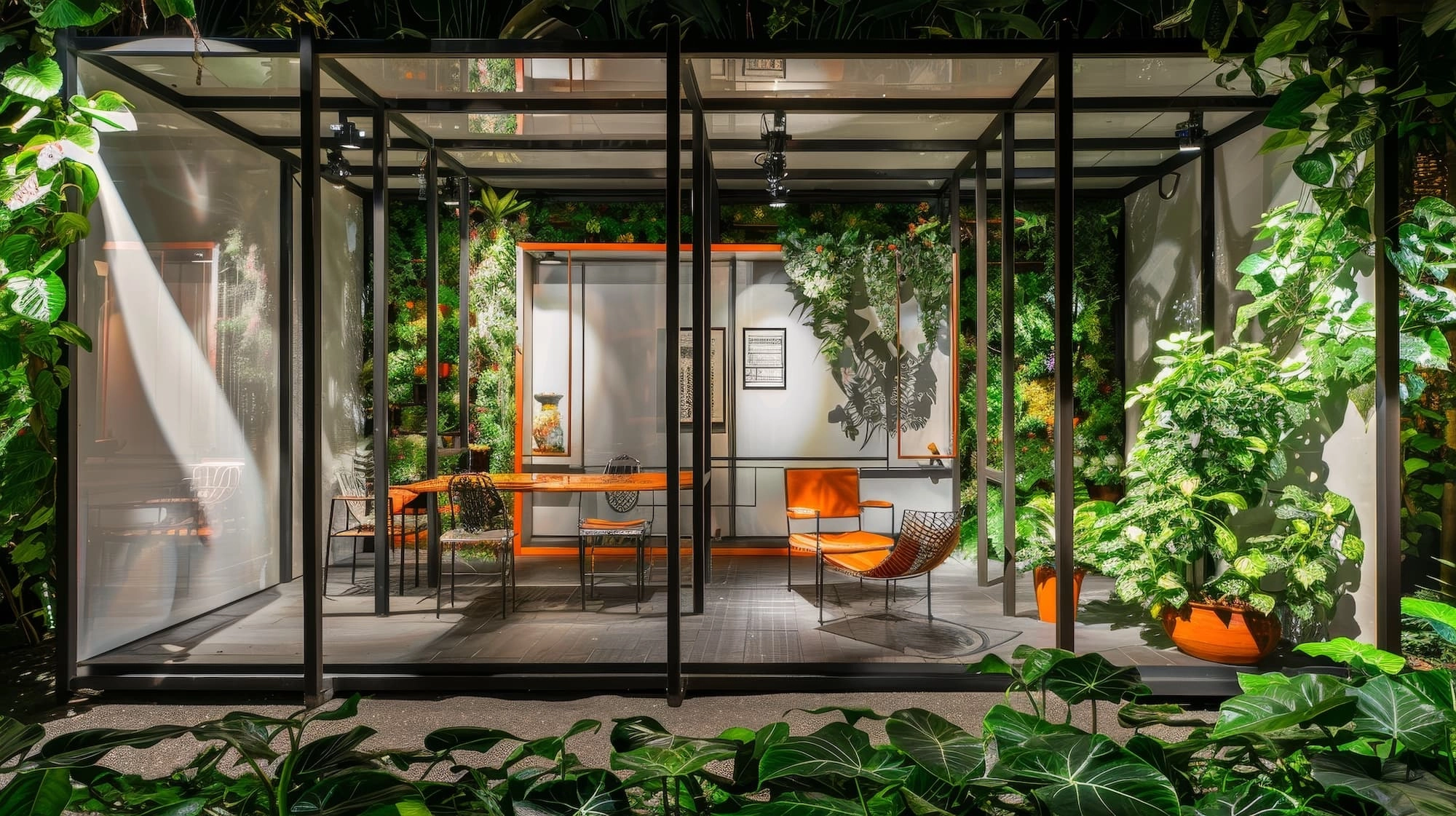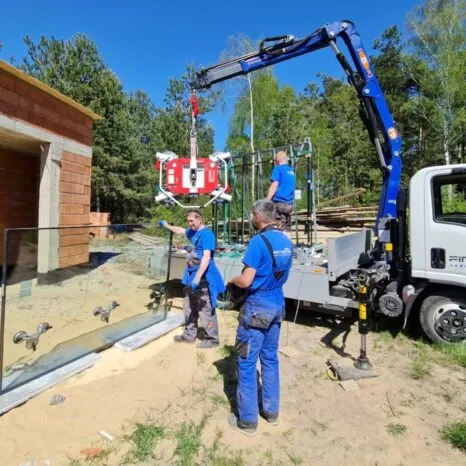
In the past, winter gardens were primarily a place to grow exotic plants and citrus trees. Elegant, domestic greenhouses offered them ideal conditions, providing optimum sunlight, humidity and temperature. Today, the role of conservatories has expanded considerably. With the right choice of furniture and accessories, glazed spaces can fulfil a variety of functions, adapting to the individual needs of the users. Do you dream of a glazed dining room overlooking the garden? Or perhaps a quiet place to work surrounded by greenery? These are just some of the many possibilities offered by the modern conservatory.
So how to arrange a winter garden in an interesting and functional way? Arranging such a space can be an extension of your home, creating a comfortable place to relax, work or socialise. We can transform our winter garden into a green oasis that will bring a tropical feel to our home or create a cosy place to help us survive the cold winter months surrounded by plants. That’s why we’ll give you a variety of inspiring winter garden design ideas below. We will suggest creating a space that is both functional and aesthetically pleasing.
Who is a conservatory for?
Winter gardens are becoming increasingly popular among those planning to build a home. What makes them so attractive? A typical conservatory is a glazed space located just outside the house. It can be completely isolated and unheated, making it function as a stand-alone conservatory, or it can be an integral part of the house as another fully heated room – something like a glass terrace or a built-in veranda.
Typically, these conservatories are placed against one of the walls of the building, usually adjacent to the living room, dining room or bedroom. This provides easy access to the rest of the house and allows us to use the conservatory on a daily basis as an extension of the interior.
For homeowners wishing to extend their living space, a prefabricated conservatory is the perfect solution. This is because these types of structures are characterised by their lightweight construction and simple assembly, which allows them to be installed even by yourself. In addition, the quick and easy installation means that we can enjoy our new space without the need for complicated building work.
Conservatories ultimately offer a variety of adaptations, depending on individual needs and preferences, making them an ideal choice for both those building a new home and those looking to extend their existing living space. Thanks to their versatility and aesthetic appeal, conservatories are becoming an integral part of modern homes, adding charm and functionality.

Types and uses of conservatories
Contemporary conservatories can perform a variety of functions, depending on their purpose and the way they are arranged. The basic criterion for their division is the method of heating, which divides them into seasonal and year-round gardens.
Seasonal conservatories, also known as cold gardens, are mainly intended for growing plants. The interior of such a garden is heated exclusively by the sun’s rays, as there is no heating system installed. This is ideal for gardening enthusiasts who want to enjoy plants for most of the year without having to invest in additional heating.
Warm conservatories, or year-round gardens, on the other hand, offer many more possibilities. With the addition of additional heating, such gardens can be used all year round. They become not only a space for growing greenery, but also a fully-fledged room that can be used as an extra room, a recreation area or a place to relax.
If the conservatory is to serve as a functional and comfortable living room all year round, it is also worth taking care to furnish it appropriately. Comfortable furniture, carefully selected plants and thoughtful interior design will create a space ideal for relaxing and spending time with loved ones. Such a conservatory will not only enrich the aesthetics of your home, but also increase its functionality, creating a cosy and practical place throughout all seasons.
How to arrange a conservatory and what to keep in mind?
Before you start building a conservatory, it’s worth thinking carefully about what its purpose will be. Do you plan to use it as a second living room, a library retreat, a place to overwinter plants, or a relaxing space filled with exotic plants? The purpose of the garden will then influence the choice of technical solutions, equipment and decoration.
It is worth remembering that the location of the conservatory is important for the type of plants that can grow in it. A south-western exposure of the conservatory creates ideal conditions for thermophilic plants and citrus trees. An eastern location, on the other hand, is better suited to species that prefer diffused light. It is also important to avoid overheating the plants in summer. Direct sunlight can cause burns and wilting of the leaves. Therefore, in order to protect the plants on the hottest days, it is advisable to install blinds, shutters, awnings or curtains to limit the light and reduce the temperature inside.
If you are arranging the conservatory as a space for relaxing or working, it will in turn be necessary to provide adequate heating. You can choose underfloor or ducted heating systems, infrared heaters or traditional garden heaters. An efficient ventilation system will also be essential, which will help to remove excess water vapour, thus preventing window evaporation and plant diseases.
The conservatory and plants – which species to choose?
The choice of plants for the interior of the conservatory depends to a large extent (as we wrote in the previous paragraph) on its location in relation to the sides of the world. If the conservatory is located on the south or west side, we can successfully grow flowers and exotic plants that need a lot of light. Tropical plants will thrive in such conditions as they will take full advantage of the abundance of sunlight. On the other hand, an east-facing conservatory offers more diffused light, making it ideal for most houseplants.
Winter gardens can also act as a winter shelter for plants that grace an outdoor space in summer. It is the perfect place to store plants that need protection from low temperatures in the colder months.
When choosing plants for a conservatory, it is furthermore worth considering species such as ivy, fern, philodendron, sepiolus, arrowroot, oleander, fig or herbaceous. These warm- and light-loving plants will find their way perfectly into the glazed space, pleasing the eye with their lush greenery. In addition, some citrus species, such as lemons and oranges, can also grow brilliantly in a winter garden, adding exotic charm and aroma.
Conservatory furniture
As we already know, the conservatory often becomes an extension of the living space in the house, acting as an additional room for relaxing and spending time with family and friends. Such a place cannot therefore lack comfortable and functional furniture. It is worth taking care of comfortable sofas, armchairs and tables, which will create a cosy atmosphere.
Depending on the chosen arrangement, we can opt for typical living room furniture, which will add an elegant touch to the interior, or versatile garden furniture, such as patio furniture, which will work perfectly both indoors and outdoors. The latter, moreover, are often more resistant to changing weather conditions, which can be beneficial in a conservatory space.
If the glazed terrace is also to be used as a dining area, it is worth thinking not only about a small bench or coffee table, but also a full-size table and an appropriate number of chairs. Such furnishings will allow you to eat comfortably surrounded by greenery, which will certainly make every moment spent in the garden more pleasant.
In addition, you may want to consider placing bookshelves in the conservatory to create a cosy reading corner. Potted plants, decorative cushions and plaids will complete the look, giving the interior a personal touch and warmth.
Which lighting is worth choosing?
The choice of lights for a conservatory should be dictated mainly by aesthetic considerations and individual preferences. Various types of lamps will work well in such a space, including classic pendant lamps placed centrally, stylish wall-mounted sconces and traditional standing lamps.
When choosing lighting, it is worth ensuring that your conservatory is equipped with both functional and decorative light sources. Powerful LED lamps, placed in the centre of the garden, will provide adequate lighting for daily activities. For decorative purposes, on the other hand, softer lamps or even LED strips can be used to subtly illuminate selected parts of the conservatory, creating a cosy atmosphere.
A combination of different types of lighting will allow you to adapt the mood in your conservatory to suit different occasions. You could also consider installing lamps with adjustable light levels, allowing you even more flexibility in creating the atmosphere.
Winter garden heating
A heated conservatory provides a comfortable environment even during winter weather, allowing this space to be used all year round. One of the most popular solutions is to install underfloor heating, often combined with the home’s heating system. Such an arrangement enables heat to be distributed easily and efficiently, which is particularly important on an enclosed terrace.
Another effective way to heat a conservatory is with skirting heaters, which can be discreetly installed along the walls to ensure the space is evenly heated.
Radiant heaters, which can be mounted on the walls or ceiling, are also ideal as an alternative heat source. With these, we can quickly raise the temperature in the conservatory, adapting it to the current needs. In turn, the combination of different heating methods will create optimum conditions in the conservatory, making it a welcoming and functional place all year round.

















